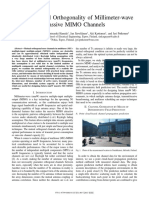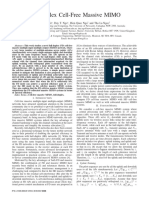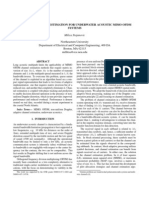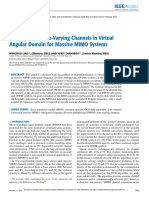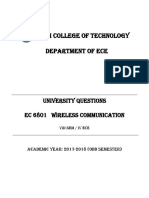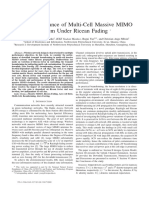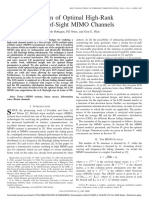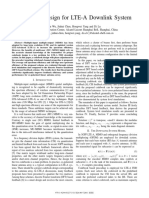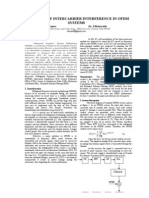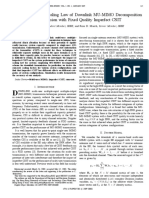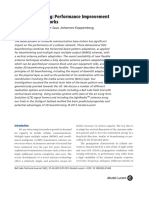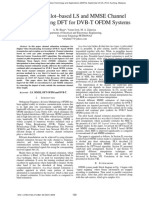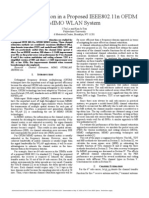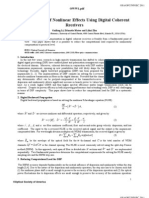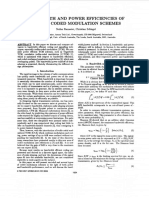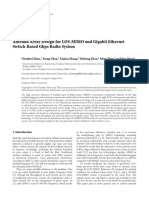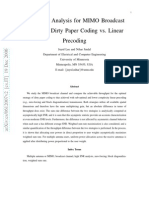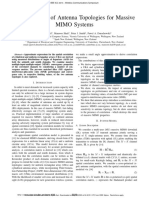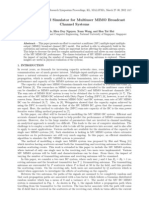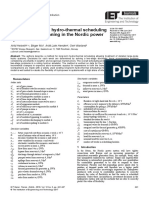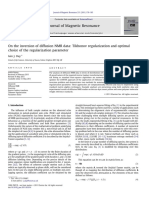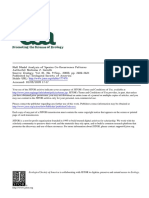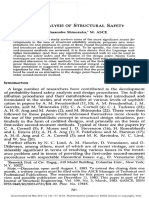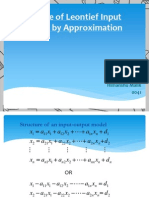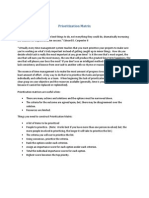Unified Channel Estimation and Scheduling For Massive MIMO Systems
Unified Channel Estimation and Scheduling For Massive MIMO Systems
Uploaded by
prabhabathi deviCopyright:
Available Formats
Unified Channel Estimation and Scheduling For Massive MIMO Systems
Unified Channel Estimation and Scheduling For Massive MIMO Systems
Uploaded by
prabhabathi deviOriginal Title
Copyright
Available Formats
Share this document
Did you find this document useful?
Is this content inappropriate?
Copyright:
Available Formats
Unified Channel Estimation and Scheduling For Massive MIMO Systems
Unified Channel Estimation and Scheduling For Massive MIMO Systems
Uploaded by
prabhabathi deviCopyright:
Available Formats
ISSN (Online) 2394-6849
International Journal of Engineering Research in Electronics and Communication
Engineering (IJERECE)
Vol 5, Issue 4, April 2018
Unified Channel Estimation and Scheduling for
Massive MIMO Systems
[1]
Dr G.Indumathi, [2] C.Prabhabathi Devi, [3] V.Priyadharshini
Department of ECE, Mepco Schlenk Engineering College, Sivakasi.
Abstract: - This paper proposes a unified channel estimation scheme for multiuser massive multiple input multiple output (MIMO)
systems in time-varying environment. In this paper, a new discrete Fourier transform (DFT) based spatial-temporal basis
expansion model (ST-BEM) is introduced to mitigate the training overhead and feedback cost by reducing the dimensions of uplink
and downlink channel. This model is suitable for both time division duplex (TDD) and frequency division duplex (FDD) systems. A
new greedy user scheduling algorithm is also introduced to improve the Spectral efficiency. Various simulation results are provided
to demonstrate the effectiveness of the proposed method.
Keywords: - Massive MIMO, Discrete Fourier Transform (DFT), ST-BEM, FDD, TDD.
I. INTRODUCTION Strategy is used. Here uplink pilot contamination,
downlink training and feedback overhead are significantly
One of the most important physical layer techniques in 5G reduced. But acquisition of channel covariance matrix
communication is massive MIMO or large scale multiple becomes a difficult task and it also leads to Eigen value
input and multiple output [8]. It can simultaneously serve decomposition (EVD) problem for high dimensional
tens of terminals in the same frequency-time with the help of covariance matrices. In this paper, using antenna array
hundreds of antennas located in Base Station (BS) side that theory and array signal processing we propose an alternate
provides robustness, high Energy efficiency and Spectral low rank model for massive Uniform linear array (ULA).
efficiency [9]. To utilize the benefits of massive MIMO This model is based on mean direction of arrivals and
effectively, the perfect channel state information (CSI) for angular spread (AS) of incident signals of each user. This
both Uplink and downlink should be acquired by Base model is known as Spatial Basis Expansion Model
station. Usually channel is estimated via pilot sequences. But (SBEM). The proposed unified transmission strategy for
in massive MIMO it leads to pilot overhead in downlink the multiuser TDD/FDD massive MIMO systems includes
channel estimation because the no of training sequences Uplink (UL) channel estimation and user scheduling for
should be equal to the no of transmit antennas and length of data transmission. It is shown that the Uplink channel
the training stream should be greater than the no of transmit estimation of multi users can be carried out with very few
antennas based on orthogonal training strategy. In uplink if training resources, and thus, the overhead of training and
the no of users or no of antennas of each user increases, then feedback can be also reduced significantly. Meanwhile,
pilot overhead problem occurs. If the training sequences are the pilot contamination in UL training can be immediately
Non-orthogonal, then so called pilot contamination problem relieved. To enhance the spectral efficiency during the
occurs. These problems are diminishing the system data transmission, a greedy user scheduling algorithm is
performance. In [10] and [11], the closed-loop training proposed where users with orthogonal spatial information
schemes were applied to sequentially design the optimal pilot are allowed to transmit simultaneously.
beam patterns. The Compressive sensing (CS)-based
feedback reduction in [12] and the distributed compressive II. SYSTEM MODEL AND CHANNEL
channel estimation in [3] extracted the channel sparsity to CHARACTERISTICS
reduce large amount of measurements feeding back to the
Base station. This Method requires knowledge of the sparsity As shown in figure.1 multiuser massive MIMO system is
level in channel matrices but it’s not an easy task to considered where the Base station (BS) is equipped with
accurately acquire such information. After these types of M (>>1) antennas in the form of uniform linear array
attempts low rank channel estimation approaches are (ULA) and K single antenna users are spread over the
introduced. These approaches reduce the effective channel coverage area. The propagation from user k to BS is
dimensions. In [1], Covariance aware pilot Assignment composed of Pr-rays (Pr>>1) due to scattering, reflection
All Rights Reserved © 2018 IJERECE 12
ISSN (Online) 2394-6849
International Journal of Engineering Research in Electronics and Communication
Engineering (IJERECE)
Vol 5, Issue 4, April 2018
and refraction. The channel is considered to be time selective The normalized DFT of channel vector exhibits some
flat fading and it will change symbol level. It’s safe to specific properties in massive ULA case. This property
assume that the physical position of users seen by the BS is used to minimize the complexity of transceiver design.
unchanged within a single block N. The corresponding M x 1 The normalized DFT can be represented as
uplink channel can be expressed as,
Pr
1
kp where, F=>MxM DFT matrix whose (p,q)th element is,
hk kp e a( kp ) (1)
pr p 1
The propagation from user to BS is assumed to be
composed of p rays. While considering single ray i.e.,
hk k a( k ) and M is infinite, the normalized DFT
has only one non-zero point and this point reflects the
DOA of the impinging signal, namely
When M is large but not infinite, the power leakage may
happen. For most cases, Non-zero point is not an integer
and the channel power will leak from the ([M(d/λ)sinθ k])th
DFT point to other DFT points. The DFT outputs are
discrete samples of DTFT of a (θk).i.e., a sinc function, at
the points of 2πq/M, q=0, 1 ….M-1. Hence the degree of
leakage in fhk is inversely proportional to the M. When
M is infinite, the large but not power leakage is not a
problem because most power of fhk is still concentrates
Fig.1 System model. Users are surrounded by pr local around this Non-zero point as shown in Fig.2. For the Multi-ray
scatterers and the mean DOA and AS f user-k are case, let Dk is the index set of continuous DFT points that
k and k respectively. When users are move around contains % of the channel power [7].
in a circle, the spatial AS seen by BS is generally
unchanged.
where, fd is the Doppler frequency and Ts is the sampling
frequency, kp is the angle between the uplink transmitted
signal and the motion direction of user-k. kp signifies the
initial phase, which is uniformly distributed in [0,2 ]
and a( kp ) is the array manifold vector and it varies based
on antenna structure.
For ULA case, array manifold vector can be represented as
2d 2d
j sin kp j ( M 1) sin kp
a(kp ) [1, e
,.........e
] (2)
where, d is the antenna spacing, λ denotes the signal
carrier wavelength, θkp represents DOA of the p-th ray. Fig.2 fhk of single incident ray with =90, M=128
The incident angular spread of user k with mean DOA It can be represented as,
( k ) is assumed to be limited in a narrow region, i.e.,
[ k k , k k ] and this angular spread (AS) of
each user is normally unaltered when the user moves Where, θk ,Δθk are DOA and AS respectively. Cmax is the
within the circular region as shown in Fig.1. maximum no of leakage points. These indices can be
viewed as spatial signature of each user. This model is
known as Spatial Basis Expansion Model (SBEM). To
All Rights Reserved © 2018 IJERECE 13
ISSN (Online) 2394-6849
International Journal of Engineering Research in Electronics and Communication
Engineering (IJERECE)
Vol 5, Issue 4, April 2018
deduce this, a perfect DOA is to be acquired. For this The preceding optimization can be achieved by sliding a
purpose, a Spatial Rotation operation is introduced. So the window of size τ over the elements in
new channel vector can be formulated as,
together by a 1-D search over
III. CHANNEL ESTIMATION WITH SBEM
where,
A unified transmission strategy for a TDD/FDD massive
MIMO system is introduced that utilizes the spatial
The Spatial Rotation operation, further concentrate the
signatures to realize orthogonal training and data
channel power within the fewer entries fhkro of for a certain
transmission among different users. As shown in Fig.4,
value of ϕ. For one-ray case, When DOA of the incident
this framework always starts with preamble period. The
signal is not arcsin(qM/λd) for some integer q i.e.,
preamble period is used to obtain the spatial signature of
mismatched with DFT points, then power leakage will
each user. After tracking spatial information of each user
happen. Formulate a new channel vector as, fh ro F ( )h .
k k the users are grouped based on their spatial signature for
If then has only one Non-zero further process.
element and so at q, with the power leakage is
eliminated, where ϕ is the shift parameter. For example in
Fig.3, Spatial rotation with ϕk= 0.34375 radian can help to
strengthen the channel sparsity of. . For the Multi-ray
cases, a new channel vectors is formulated and define
as the continuous index set such that Fig.4 Communication Framework
contains at least ŋ% of the channel power and search ϕ from Here we consider the users are present within a cell and τ
(< K) orthogonal training sequences with length L (< T)
and select the optimal ϕk that minimizes the are available and the corresponding orthogonal training
The standards are normally regulated by considering channel set will be S=[s1,s2,.....sτ] € CLxτ with SiHSj=Lσp2δ(i-j)
parameters to be estimated as fixed but here a dynamically where σp2 is the signal training power.
changing parameter is considered. Define the set containing
continuous τ integers as where τ is the number of Tracking of Spatial information through preamble Assume
channel parameters that system could handle. Then select the K=Gτ. Since we do not have any prior spatial information
spatial signature set and corresponding shift parameter for about users, we will have to divide the users into G groups
user k by using following optimization, each containing τ users such that τ orthogonal training
sequences are enough for each group and conventional
estimation methods are applied and length of the preamble
is Gτ.
The received signals at the BS is given by,
hk can be estimated using Least Square as,
where, H=[h1,h2,…….hτ] € CMxτ , S=[s1,s2,.....sτ] € CLxτ and
Pkut
D=diag[d1,……dτ] and dk is used to satisfy the
p2
uplink training energy constraint for user-k, N is the
Fig.3 Comparison of single ray channels with/without additive white Gaussian noise. Repeating the similar
spatial rotation operations in (7) for all G groups is used to obtain the
All Rights Reserved © 2018 IJERECE 14
ISSN (Online) 2394-6849
International Journal of Engineering Research in Electronics and Communication
Engineering (IJERECE)
Vol 5, Issue 4, April 2018
estimates of all K users. The next step is to obtain the optimal
shift parameter ϕk and spatial signature set of size τ for each
user, as described in (5). The obtained channel information
from preamble may only last for a short period for example
one coherent time while it needs to be re estimated or
tracked for later transmission. When a user and its
surrounding obstacles does not change the position within the
comparable time then no need to track the spatial information
for few channel coherent times and only the accompanied
[ fhkro ] B ro ,: should be re estimated. The Non-overlapping
k
properties of different spatial signatures are used to
overcome the insufficient problem of orthogonal training
sequences. After obtaining of spatial signature of each user
we may schedule them using Non-overlapping property of
spatial signatures and also throughput is considered to
improve the performance of each group.
IV. DATA TRANSMISSION WITH USER
SECHEDULING
A greedy user scheduling algorithm is considered where the V. SIMULATIONS
strongest channel gain first join the empty group and then
other users with non-overlapping spatial signatures can join
the same group only if the achievable sum rate increases In this section the effectiveness of the proposed strategy is
afterwards. demonstrated using numerical examples. We select
________________________________________ M=128, K=32,d=λ/2. The channel vectors of different
User scheduling Algorithm users are formulated using (1) and we consider Pr=100,
STEP-1:Calculate the Euclidean norm of the estimated fd=200 Hz and Ts=1μs and kp is randomly taken from
channel vectors, i.e., [ fhkro ]B ro ,: for all users. CN(0,1) for all rays and all users, kp is distributed
k
dd
STEP-2:Initialize g=1, P=0, Ug = NULL, R(Ug |P)= 0 and the dd
inside [ k k , k k ] . And AS = 2 degree for
remaining user set Ur={1,…….K}.
all users. The system coherence interval is set as T=128
STEP-3:For the gth group, select the user with the maximum norm
of channel in user set l ' arg max and τ =16. The length of the pilot symbol should satisfy
lU r
ehl and remove the 16≤L≤128. L may be 16, 32 and 64. The signal to noise
user
from user set and add the user in Ugdd. p2
STEP-4:Select all users Ur whose spatial signatures are Non- ratio defined as, . The channel estimation
overlapping with users in Ugdd and denote them by, Ug’. For Eg., n2
u' g {mur Bmro Blro , l U gdd } performance metric in terms Mean square error(MSE) is
represented as
Fig.5 shows comparison of MSE performances with
different L values. It is observed that when L increases the
MSE decreases. The total power for uplink training
considered is Pkut= Lρ for all users.
All Rights Reserved © 2018 IJERECE 15
ISSN (Online) 2394-6849
International Journal of Engineering Research in Electronics and Communication
Engineering (IJERECE)
Vol 5, Issue 4, April 2018
VI. CONCLUSIONS
In this paper we exploited the characteristics of ULA and
proposed a simple DFT based ST-BEM to represent the
channel vectors with reduced parameters which helps to
reduce the pilot overhead and feedback cost. The Uplink
spatial signatures can be used for Downlink also based on
the property angle reciprocity. This method applicable for
both TDD/FDD massive-MIMO systems. Various
numerical results are provided to demonstrate the
effectiveness of the proposed approach.
REFERENCES
Fig.5 MSE performances for different L values
[1] A.Adhikary, J. Nam, J.-Y. Ahn, and G. Caire, ―Joint
spatial division and multiplexing— the large-scale array
Fig.6 explains about MSE performance improvement with
regime,‖ IEEE Trans. Inf.Theory,vol. 59, no. 10, pp.
and without spatial rotation operation.
6441–6463, Oct. 2013.
[2] H. Yin, D. Gesbert, M. Filippou, and Y. Liu, ―A
coordinated approach to channel estimation in large-scale
multiple-antenna systems,‖ IEEE J. Sel.Areas Commun.,
vol. 31, no. 2, pp. 264–273, Feb. 2013.
[3] X. Rao and V. K. Lau, ―Distributed compressive CSIT
estimation and feedback for FDD multi-user massive
MIMO systems,‖ IEEE Trans.Signal Process., vol. 62, no.
12, pp. 3261–3271, Jun. 2014.
[4] Hongxiang Xie, Feifei Gao, Shun Zhang, and Shi Jin,
―A Unified Transmission Strategy for TDD/FDD Massive
MIMO Systems With Spatial Basis Expansion Model,‖
Fig.6 MSE performances for with and without spatial IEEE Transactions on vehicular technology, vol. 66, no. 4,
rotation Apr 2017.
[5] G. B. Giannakis and C. Tepedelenlioglu, ―Basis
expansion models and diversity techniques for blind
identification and equalization of time-varying channels,‖
Proc. IEEE, vol. 86, no. 10, pp. 1969–1986,Oct. 1998.
[6] S. P. Boyd and L. Vandenberghe, Convex
Optimization. Cambridge,MA, USA: Cambridge Univ.
Press, 2004.
[7] Hongxiang Xie, Feifei Gao, Shun Zhang, and Shi Jin,
―A Simple DFT-aided Spatial Basis Expansion Model and
Channel Estimation Strategy for TDD/FDD Massive
Fig.7 AASR of the proposed scheme and conventional MIMO Systems,‖ arXiv:1511.04841v6 [cs.IT] 9 Jan 20.
LS From Fig.7, it is observed that the AASR of proposed
SBEM is providing better performance than conventional [8] F. Rusek et al., ―Scaling up MIMO: Opportunities and
Least square (LS) method. challenges with very large arrays,‖ IEEE Signal Process.
Mag., vol. 30, no. 1, pp. 40–60, Jan. 2013.
All Rights Reserved © 2018 IJERECE 16
ISSN (Online) 2394-6849
International Journal of Engineering Research in Electronics and Communication
Engineering (IJERECE)
Vol 5, Issue 4, April 2018
[9] E. Larsson, O. Edfors, F. Tufvesson, and T. Marzetta,
―Massive MIMO for next massive MIMO systems: Open-
loop and closed-loop training with memory,‖ IEEE J. Sel.
Topics Signal Process., vol. 8, no. 5, pp. 802–814, Oct. 2014.
[10] J. Choi, D. J. Love, and P. Bidigare, ―Downlink training
techniques for FDD massive MIMO systems: Open-loop and
closed-loop training with memory,‖ IEEE J. Sel. Topics
Signal Process., vol. 8, no. 5, pp. 802–814, Oct. 2014.
[11] A. Duly, T. Kim, D. Love, and J. Krogmeier, ―Closed-
loop beam alignment for massive MIMO channel
estimation,‖ IEEE Commun. Lett., vol. 18, no. 8, pp. 1439–
1442, Aug. 2014.
[12] P. H. Kuo, H. Kung, and P. A. Ting, ―Compressive
sensing based channel feedback protocols for spatially-
correlated massive antenna arrays,‖ in Proc. IEEE WCNC,
Shanghai, China, Apr. 2012, pp. 492–497.
All Rights Reserved © 2018 IJERECE 17
You might also like
- Automated Broad and Narrow Band Impedance Matching for RF and Microwave CircuitsFrom EverandAutomated Broad and Narrow Band Impedance Matching for RF and Microwave CircuitsNo ratings yet
- Simulation of Digital Communication Systems Using MatlabFrom EverandSimulation of Digital Communication Systems Using MatlabRating: 3.5 out of 5 stars3.5/5 (22)
- H1038 Programming For Engineers: InstructionsDocument3 pagesH1038 Programming For Engineers: InstructionsHassanImranNo ratings yet
- Modification of An Open Area Okumura-Hata Propagation Model Suitable For OmanDocument4 pagesModification of An Open Area Okumura-Hata Propagation Model Suitable For Omanm.irfanzaidi34No ratings yet
- On The Mutual Orthogonality of Millimeter-Wave Massive MIMO ChannelsDocument5 pagesOn The Mutual Orthogonality of Millimeter-Wave Massive MIMO ChannelsFakhar AbbasNo ratings yet
- Vu 2019Document6 pagesVu 2019Sofia Kara MostefaNo ratings yet
- Adaptive Channel Estimation For Underwater Acoustic Mimo Ofdm SystemsDocument6 pagesAdaptive Channel Estimation For Underwater Acoustic Mimo Ofdm SystemsDHBKHNDT6No ratings yet
- Unified Channel Estimation and Scheduling For Massive MIMO SystemsDocument5 pagesUnified Channel Estimation and Scheduling For Massive MIMO Systemsprabhabathi deviNo ratings yet
- Non-Coherent Multiuser Massive MIMO-OFDM With Differential ModulationDocument6 pagesNon-Coherent Multiuser Massive MIMO-OFDM With Differential ModulationKarim Abd El HamidNo ratings yet
- Estimation of Time-Varying Channels in Virtual Angular Domain For Massive MIMO SystemsDocument11 pagesEstimation of Time-Varying Channels in Virtual Angular Domain For Massive MIMO Systemsbvkarthik2711No ratings yet
- Structured Compressive Sensing Based Superimposed Pilot Design in Downlink Large-Scale MIMO SystemsDocument3 pagesStructured Compressive Sensing Based Superimposed Pilot Design in Downlink Large-Scale MIMO SystemsFahd SaifNo ratings yet
- Agni College of Technology Department of Ece: University Questions Ec 6801 Wireless CommunicationDocument103 pagesAgni College of Technology Department of Ece: University Questions Ec 6801 Wireless CommunicationKutty ShivaNo ratings yet
- MIMO-OFDM Channel Estimation Based On Subspace Tracking: Jianxuan Du and Ye (Geoffrey) LiDocument5 pagesMIMO-OFDM Channel Estimation Based On Subspace Tracking: Jianxuan Du and Ye (Geoffrey) LiRutuja ShedsaleNo ratings yet
- Massive MIMO in The UL DL of Cellular Networks How Many Antennas Do We NeedDocument12 pagesMassive MIMO in The UL DL of Cellular Networks How Many Antennas Do We NeedsowNo ratings yet
- Area Performance of Multi-Cell Massive MIMO System Under Ricean FadingDocument6 pagesArea Performance of Multi-Cell Massive MIMO System Under Ricean FadingLavish KansalNo ratings yet
- CM Kaltfl 080709Document5 pagesCM Kaltfl 080709Võ Quy QuangNo ratings yet
- Design of Optimal High-Rank Line-of-Sight MIMO ChannelsDocument6 pagesDesign of Optimal High-Rank Line-of-Sight MIMO Channelschandan kumar sheemarNo ratings yet
- Codebook Design For Lte-AdvDocument5 pagesCodebook Design For Lte-AdvYasser NaguibNo ratings yet
- Path Loss Study of Lee Propagation Model: AbstractDocument4 pagesPath Loss Study of Lee Propagation Model: AbstractInternational Journal of Engineering and TechniquesNo ratings yet
- Blind Channel Estimation For MIMO Uplink MC-CDMA Systems With Layered Space Frequency EqualisationDocument4 pagesBlind Channel Estimation For MIMO Uplink MC-CDMA Systems With Layered Space Frequency EqualisationAliAlissNo ratings yet
- Massive MIMO With Per-Antenna Power Constraint: Shuowen Zhang, Rui Zhang, and Teng Joon LimDocument5 pagesMassive MIMO With Per-Antenna Power Constraint: Shuowen Zhang, Rui Zhang, and Teng Joon LimelhamNo ratings yet
- Reduction of Intercarrier Interference in Ofdm Systems: R.Kumar Dr. S.MalarvizhiDocument5 pagesReduction of Intercarrier Interference in Ofdm Systems: R.Kumar Dr. S.MalarvizhiUsman TariqNo ratings yet
- Eigen Value Based (EBB) Beamforming Precoding Design For Downlink Capacity Improvement in Multiuser MIMO ChannelDocument7 pagesEigen Value Based (EBB) Beamforming Precoding Design For Downlink Capacity Improvement in Multiuser MIMO ChannelKrishna Ram BudhathokiNo ratings yet
- Radio Propagation ModelingDocument24 pagesRadio Propagation Modelingcoolboy_usamaNo ratings yet
- Reconfigurable ULAs For Line-of-Sight MIMO TransmissionDocument15 pagesReconfigurable ULAs For Line-of-Sight MIMO Transmissionchandan kumar sheemarNo ratings yet
- Channel Estimation For Millimeter-Wave Massive MIMO With Hybrid Precoding Over Frequency-Selective Fading ChannelsDocument4 pagesChannel Estimation For Millimeter-Wave Massive MIMO With Hybrid Precoding Over Frequency-Selective Fading ChannelsZorba ZorbaNo ratings yet
- ICC14Document6 pagesICC14xuesonglNo ratings yet
- Mimo Limited FeedbackDocument5 pagesMimo Limited FeedbackYasser NaguibNo ratings yet
- 3D Beamforming - Performance Improvement For Cellular NetworksDocument20 pages3D Beamforming - Performance Improvement For Cellular NetworksxinlivuNo ratings yet
- MIMO OFDM Limted FeedbackDocument6 pagesMIMO OFDM Limted FeedbackYasser NaguibNo ratings yet
- LS MmseDocument5 pagesLS MmserkpvvvNo ratings yet
- Channel Estimation in A Proposed IEEE802.11n OFDM MIMO WLAN SystemsDocument5 pagesChannel Estimation in A Proposed IEEE802.11n OFDM MIMO WLAN Systemskhajarasool_skNo ratings yet
- Energy Efficient Channel Estimation in MIMO Systems: Sarod Yatawatta, Athina P. Petropulu Charles J. GraffDocument4 pagesEnergy Efficient Channel Estimation in MIMO Systems: Sarod Yatawatta, Athina P. Petropulu Charles J. GraffgbafnaNo ratings yet
- Optimum Power Allocation For Fading Relay Channels: Muhammad Mehboob Fareed and Murat UysalDocument5 pagesOptimum Power Allocation For Fading Relay Channels: Muhammad Mehboob Fareed and Murat UysalballmerNo ratings yet
- Of Cdma: Performance Multi-Code in A Multipath Fading ChannelDocument6 pagesOf Cdma: Performance Multi-Code in A Multipath Fading Channelfeku fekuNo ratings yet
- MIMO-OFDM Channel Estimation For Correlated Fading Channels: TX RXDocument4 pagesMIMO-OFDM Channel Estimation For Correlated Fading Channels: TX RXkhanziaNo ratings yet
- Angle-Delay-Doppler Domain NOMA Over Massive MIMO-OTFS NetworksDocument6 pagesAngle-Delay-Doppler Domain NOMA Over Massive MIMO-OTFS NetworksLavish KansalNo ratings yet
- MIMO-OFDM Channel Estimation For Correlated Fading Channels: TX RXDocument4 pagesMIMO-OFDM Channel Estimation For Correlated Fading Channels: TX RXNizar Ben Hadj YahiaNo ratings yet
- Coh 1Document2 pagesCoh 1chunnumunnuNo ratings yet
- Impulse Response Modeling of Indoor Radio Propagation ChannelsDocument12 pagesImpulse Response Modeling of Indoor Radio Propagation ChannelsIsidro Miguel Calvo AsínNo ratings yet
- Nonlinear Power Response in Heterodyne Photonic Radiometers For Microwave Remote SensingDocument4 pagesNonlinear Power Response in Heterodyne Photonic Radiometers For Microwave Remote SensingGergő BárdosNo ratings yet
- Bandwidth and Power Efficiencies of Trellis Modulation: Coded SchemesDocument5 pagesBandwidth and Power Efficiencies of Trellis Modulation: Coded Schemesamit sahuNo ratings yet
- Spatial Scheduling Algorithms For Wireless SystemsDocument4 pagesSpatial Scheduling Algorithms For Wireless Systemsthemartinmspam2490No ratings yet
- Jurnal_V2Document12 pagesJurnal_V2fan tazNo ratings yet
- Channel Capacity of MIMO FSO System Under Strong Turbulent ConditionDocument5 pagesChannel Capacity of MIMO FSO System Under Strong Turbulent ConditionHusam Abduldaem MohammedNo ratings yet
- How To Scale Up The Spectral Efficiency of Multi-Way Massive MIMO Relaying?Document6 pagesHow To Scale Up The Spectral Efficiency of Multi-Way Massive MIMO Relaying?hendra lamNo ratings yet
- Performance Analysis of Decode-and-Forward Relay Network Under Adaptive M-QAMDocument5 pagesPerformance Analysis of Decode-and-Forward Relay Network Under Adaptive M-QAMballmerNo ratings yet
- Research Article: Antenna Array Design For LOS-MIMO and Gigabit Ethernet Switch-Based Gbps Radio SystemDocument11 pagesResearch Article: Antenna Array Design For LOS-MIMO and Gigabit Ethernet Switch-Based Gbps Radio SystemrspalomoNo ratings yet
- DFT and Double CodebookDocument5 pagesDFT and Double CodebookYasser NaguibNo ratings yet
- SCVT FinalDocument6 pagesSCVT FinalAbhishek Parochi Engineer thisNo ratings yet
- High SNR Analysis For MIMO Broadcast Channels: Dirty Paper Coding vs. Linear PrecodingDocument33 pagesHigh SNR Analysis For MIMO Broadcast Channels: Dirty Paper Coding vs. Linear Precodingkumaar1943No ratings yet
- Asynchronous Ds-Cdma System For Vsat S A T E L L I T E Communication NetworksDocument5 pagesAsynchronous Ds-Cdma System For Vsat S A T E L L I T E Communication NetworksMohit VermaNo ratings yet
- Comparative Performance Analysis of Different Modulation Techniques For Papr Reduction of Ofdm SignalDocument11 pagesComparative Performance Analysis of Different Modulation Techniques For Papr Reduction of Ofdm SignalsunilsrsanNo ratings yet
- On The Impact of Antenna Topologies For Massive MIMO SystemsDocument6 pagesOn The Impact of Antenna Topologies For Massive MIMO SystemsLydia IskandarNo ratings yet
- Lecture 1Document69 pagesLecture 1billyNo ratings yet
- Data Throughputs Using Multiple-Input Multiple-Output (Mimo) Techniques in A Noise-Limited Cellular EnvironmentDocument40 pagesData Throughputs Using Multiple-Input Multiple-Output (Mimo) Techniques in A Noise-Limited Cellular EnvironmentloaidNo ratings yet
- A Comparative Analysis of LS and MMSE Channel Estimation Techniques For MIMO-OFDM SystemDocument6 pagesA Comparative Analysis of LS and MMSE Channel Estimation Techniques For MIMO-OFDM SystempreetiNo ratings yet
- A Simple Channel Simulator For Multiuser MIMO Broadcast Channel SystemsDocument6 pagesA Simple Channel Simulator For Multiuser MIMO Broadcast Channel SystemsskynetoNo ratings yet
- Impact of Nonlinear Power Amplifiers On The Performance of Precoded MIMO Satellite SystemsDocument7 pagesImpact of Nonlinear Power Amplifiers On The Performance of Precoded MIMO Satellite Systemsntnam113No ratings yet
- Radio Propagation and Adaptive Antennas for Wireless Communication Networks: Terrestrial, Atmospheric, and IonosphericFrom EverandRadio Propagation and Adaptive Antennas for Wireless Communication Networks: Terrestrial, Atmospheric, and IonosphericNo ratings yet
- Press Release No.279 Date: 20.04.2020Document1 pagePress Release No.279 Date: 20.04.2020prabhabathi deviNo ratings yet
- Current Affairs PDF Plans: Help Us To Grow & Provide Quality ServiceDocument19 pagesCurrent Affairs PDF Plans: Help Us To Grow & Provide Quality Serviceprabhabathi deviNo ratings yet
- Ac GK CapsuleDocument280 pagesAc GK CapsuleRamesh SharmaNo ratings yet
- Kannodu Kanbathellam PDFDocument49 pagesKannodu Kanbathellam PDFprabhabathi deviNo ratings yet
- Ubiquitous Computing Is A Paradigm in Which The Processing of Information Is Linked With Each Activity or Object As EncounteredDocument3 pagesUbiquitous Computing Is A Paradigm in Which The Processing of Information Is Linked With Each Activity or Object As Encounteredprabhabathi deviNo ratings yet
- Choosing Parameters of Kernel Subspace LDA For Recognition of Face Images Under Pose and Illumination VariationsDocument57 pagesChoosing Parameters of Kernel Subspace LDA For Recognition of Face Images Under Pose and Illumination Variationsprabhabathi deviNo ratings yet
- Hel Seth 2017Document7 pagesHel Seth 2017prabhabathi deviNo ratings yet
- Monitoring Online Test Through Data Exploration and Knowledge DiscoveryDocument4 pagesMonitoring Online Test Through Data Exploration and Knowledge Discoveryprabhabathi deviNo ratings yet
- UserManual CMS PDFDocument46 pagesUserManual CMS PDFprabhabathi deviNo ratings yet
- Expert Systems With Applications: Ying Wang, Jianzhong Zhou, Chao Zhou, Yongqiang Wang, Hui Qin, Youlin LuDocument8 pagesExpert Systems With Applications: Ying Wang, Jianzhong Zhou, Chao Zhou, Yongqiang Wang, Hui Qin, Youlin Luprabhabathi deviNo ratings yet
- Class Xii Maths Set A-1Document10 pagesClass Xii Maths Set A-1nathanaelkbinu.soiNo ratings yet
- Quizz MTH603Document11 pagesQuizz MTH603bc170401540 MUHAMMAD SHAHIDNo ratings yet
- Journal of Magnetic Resonance: Iain J. DayDocument8 pagesJournal of Magnetic Resonance: Iain J. DayLeonardo JaimesNo ratings yet
- SSRN Id1404905 PDFDocument20 pagesSSRN Id1404905 PDFalexa_sherpyNo ratings yet
- Basic Image Processing #1Document55 pagesBasic Image Processing #1yusuf23004No ratings yet
- Locs HK Rs c4 PDFDocument49 pagesLocs HK Rs c4 PDF何家銘No ratings yet
- Curious Freaks Coding SheetDocument7 pagesCurious Freaks Coding SheetKowsika RavikumarNo ratings yet
- Indirect Addressing S5 S7Document35 pagesIndirect Addressing S5 S7xl_hamo0% (1)
- Levarge - Semigroup of Linear OperatorsDocument17 pagesLevarge - Semigroup of Linear OperatorsCristian ValdezNo ratings yet
- Reviewer MAED MATHDocument9 pagesReviewer MAED MATHJày CaneteNo ratings yet
- Mit18 06scf11 Ses1.5sumDocument3 pagesMit18 06scf11 Ses1.5sumZille SubhaniNo ratings yet
- Null Model Analysis of Species Co-Occurrence PatternsDocument17 pagesNull Model Analysis of Species Co-Occurrence PatternsalejaNo ratings yet
- Experiment No. 2Document22 pagesExperiment No. 2Darrel Damo PasaloNo ratings yet
- Four Lectures On Computational Statistical Physics: February 2009Document38 pagesFour Lectures On Computational Statistical Physics: February 2009Tim JohnsonNo ratings yet
- Shinozuka (1983) Basic Analysis of Structural SafetyDocument20 pagesShinozuka (1983) Basic Analysis of Structural SafetyFlavia GelattiNo ratings yet
- Cayley Hamilton ExamplesDocument3 pagesCayley Hamilton Exampleshardcore85No ratings yet
- Bergin, Jim - Mathematics For Economists With Applications-Routledge (2015)Document713 pagesBergin, Jim - Mathematics For Economists With Applications-Routledge (2015)MARIANA SOFIA BELEN FERJ VARGASNo ratings yet
- Hartmann F. The Mathematical Foundation of Structural Mechanics. 1985. 371pDocument382 pagesHartmann F. The Mathematical Foundation of Structural Mechanics. 1985. 371pqazsNo ratings yet
- 2.2.5 Basic Properties of Eigenvalue Problems: 2.2 Linear Algebra and Eigenvalues ProblemsDocument57 pages2.2.5 Basic Properties of Eigenvalue Problems: 2.2 Linear Algebra and Eigenvalues ProblemsAbdulaziz H. Al-MutairiNo ratings yet
- Section 2: Systems of Linear EquationsDocument10 pagesSection 2: Systems of Linear EquationsDidula ThrimannaNo ratings yet
- Mémoire Final Menasra AminaDocument105 pagesMémoire Final Menasra Aminaأمينة مناصرةNo ratings yet
- Arrays: Oxford University Press 2010. All Rights ReservedDocument19 pagesArrays: Oxford University Press 2010. All Rights Reservedcoolrohitkumar666No ratings yet
- An Optimal Parallel Jacobi-Like Solution Method For The Singular Value DecompositionDocument7 pagesAn Optimal Parallel Jacobi-Like Solution Method For The Singular Value Decompositionshock643No ratings yet
- LN Week1Document24 pagesLN Week1willtunaNo ratings yet
- Approximation of Inverse of Leonteif ModelDocument9 pagesApproximation of Inverse of Leonteif ModelJennifer Lopez100% (1)
- I B.SC COMPUTER SCIENCE (2013-2016) Semester-I Allied: Numerical and Statistical Methods-107B Multiple Choice QuestionsDocument35 pagesI B.SC COMPUTER SCIENCE (2013-2016) Semester-I Allied: Numerical and Statistical Methods-107B Multiple Choice QuestionsAkshaysagar.gNo ratings yet
- Visual Basic TutorialDocument17 pagesVisual Basic TutorialflyinzeskyNo ratings yet
- Antenna and Wave PropagationDocument4 pagesAntenna and Wave Propagationapecevsb100% (1)
- Prioritization MatrixDocument6 pagesPrioritization Matrixkingson007No ratings yet




